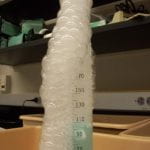DESCRIPTION:
CO2 gas from subliming dry ice gets caught in a soapy solution creating a column of bubbles. When the bubbles are popped, the “fog” that we see is condensed water vapor, not carbon dioxide gas.
TOPICS COVERED:
– cryogenics
– sublimation
– condensation
– physical change
MATERIALS NEEDED:
– 250 mL graduated cylinder
– dry ice
– water
– dish liquid
– tray for the graduated cylinder
– stir rod
– food coloring (optional)
PROCEDURE:
1. Place the graduated cylinder in a tray to catch bubble overflow
2. Put a few drops of food coloring in the bottom of the graduated cylinder
3. Line the inside top wall of the graduated cylinder with dish soap
4. Fill the graduated cylinder most of the way full with warm water
5. Add dry ice chunks,
ADDITIONAL COMMENTS:
A little food coloring makes it easy to see where the liquid and bubbles in the cylinder separate. Using a stirring rod to submerge the dry ice into the water causes more bubbles to come out quicker.
SAFETY:
Dry ice is a cryogenic that causes bad burns and should never be handled with bare skin. Caution should be taken and goggles worn at all times.
REFERENCES:
“Awesome Dry Ice Experiments.” Steve Spangler Science. Accessed 15 Jul 2011. http://www.stevespanglerscience.com/experiment/awesome-dry-ice-experiments


